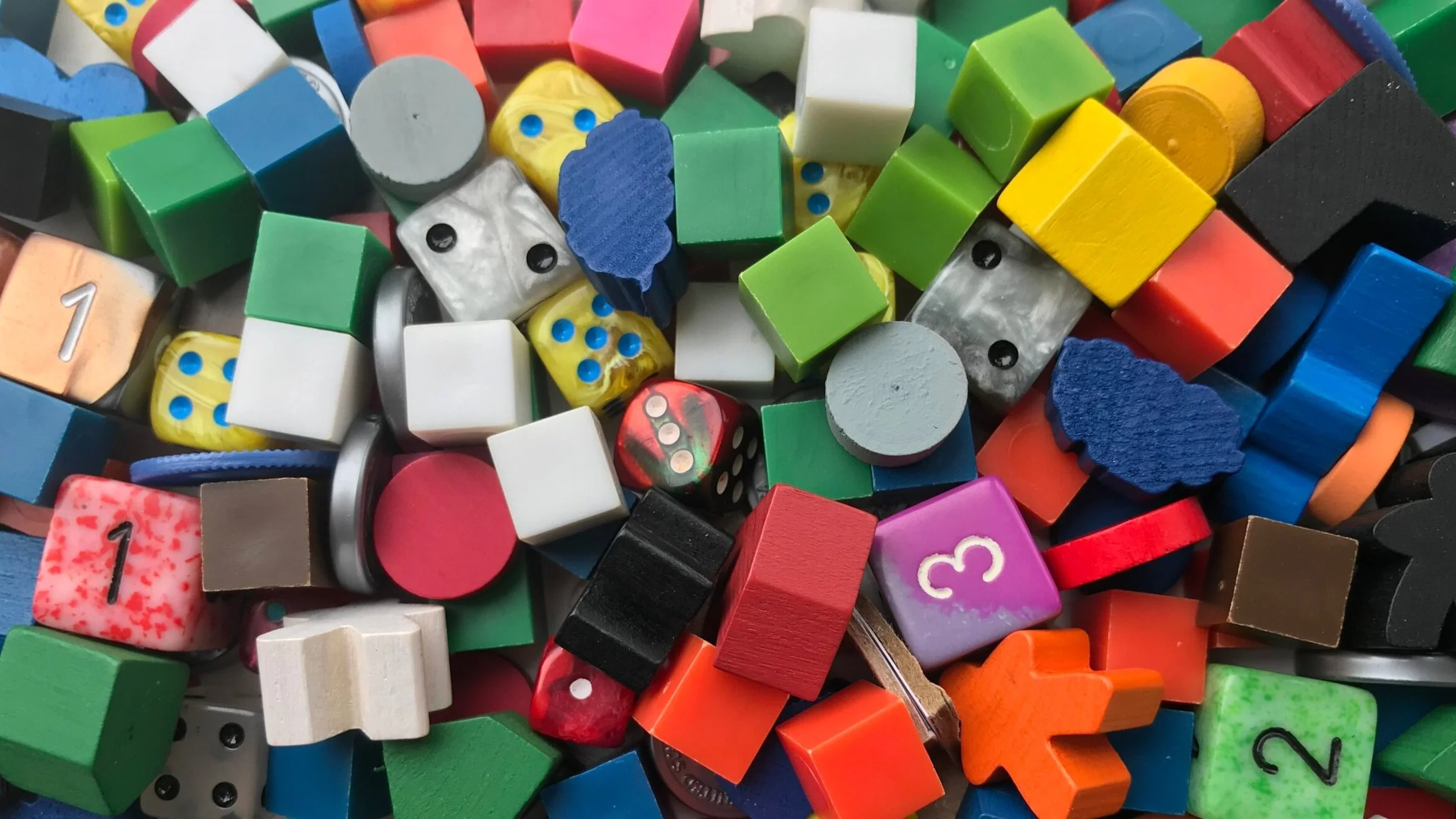Guest Post: Games as Kids--Why Designers Need to Listen to Others
/By Doug Levandowski
As a teacher, one of the hardest things for me to see is when there’s something legitimately wrong with a kid and the parents just aren’t able to see it. In the good cases, the parent agrees to have the student evaluated by someone who’s qualified to determine if the student indeed has a learning disability. In the bad cases, the parents refuse to have their child tested.
But in the worst cases–and these have happened–parents have consented to tests and then rejected the results. “Bobby doesn’t have ADHD. He’s just lazy.” “Mary can’t have a problem reading. She’s very good at math.”
As game designers, we can do exactly the same thing that these parents do. To break down the analogy, the designer is the parent and the game is the kid, because if you’re really passionate about your game, it sure can feel a bit like a child. It’s something you created, molded, shaped–and eventually want to release into the world to find its own way. And, to close out the analogy, the teachers, guidance counselors, and psychologists are all varying levels of playtesters. The teachers and guidance counselors are the players who help you playtest–whether they’re your close friends who playtest all the time and remember when the game was in its Sharpie-on-half-an-index-card stage or whether they’re the good folks who signed up to playtest at a con.
The psychologists, though: Those are the experts at gaming. They won’t have as deep an engagement with your game for a variety of reasons–but they are very good at diagnosing issues, especially when a game is brought to them with a specific problem and it’s a problem that they have expertise in. (And you won’t have much time with them, so if you ever do have a chance to get their feedback, go in with questions and make every second count.)
At Metatopia a few weekends ago, I had the chance to get feedback from all of those sorts of people–about a few of my “kids.” (Pro tip, folks: 4 games is too many to bring to a weekend-long playtesting event. Your week before will be brutal, and two weeks later, you’ll still be catching up on the stuff you had to ignore in the rest of your life.) And, based on what happened there, I had the revelation that, even though these games might be like my children, I don’t know everything about them.
Father doesn’t know best
One of the games that I brought with me I brought because I love the concept, think the mechanics are nifty, and hate the gameplay. I was giving this game, Gter Ma, its last hurrah before–I thought–retiring it for good in the games-I-tried-to-make-but-couldn’t-polish folder that every designer has. And the first playtest went exactly as I expected: One player took so long to set up that the other player was bored–and the minute or so of play before another few minutes of setup wasn’t engaging enough for the players. What’s worse, when one side pulled ahead, there was virtually no way for the other side to catch up. (I’m over-simplifying a bit, but this article’s about the lesson, not the games.)
The second playtest began the same way–until one playtester said, “Hey…What if the actions that one side got were determined by how well the other side does on the previous round?” And bam. The game was, more or less, fixed. I played a game that way with him, and it was quicker to play, tense throughout, and a real challenge for both of us. Rather than dumb luck (which had been how either side won previously), the simple change made the game into what I’d intended it to be: a bluffing game with hidden tiles where both sides have a (roughly) equal shot at winning. Now, far from being relegated to the also-rans, Gter Ma is a game I’ll be working carefully on…when I get through my others.
In addition to not knowing how to fix something in our games, designers can grossly underestimate their games, too. Another game that I brought, Circus Divas, is a very, very light dice-purchasing-then-rolling game that has almost no strategy beyond when you buy and when you save money to hit your $100 goal. I’ve enjoyed playing it because I like yelling at dice, but I figured that most other players wouldn’t. If for no other reason, I thought because my mom, who once quit Settlers of Catan because the tiles were a pain to set up, loves it. Like, insisted-we-play-five-games-in-a-row-the-first-time-we-played-it loves it. While that’s nice and all, she’s not exactly the audience at Metatopia. But, scientific inquiry got the better of me–and I was paying the same amount to bring three games as four anyway.
Well, it seems I underestimated how much other players like to yell at dice, too. It was the game that had the most players (I think I had six two-player games running at one point), and I was shocked. Sure, there was a guy who didn’t like it (I’ll come back to him later in the article), but the fun factor was something that I grossly underestimated. So, if there’s a moral to be gleaned there, it’s that in the same way that parents can sometimes write their kids off as not good at English because they don’t spend every free moment reading, just because you’re not seeing something in a game doesn’t mean that you shouldn’t try it out with a bunch of different players; they just might surprise you.
Father really doesn’t know best
One game that a friend and I have been working on for about a year, Gothic Doctor, came with me, too, and the playtests went as expected. Better, actually. There’s been one sticky issue with it–that of drawing a bad hand at the start–but we haven’t figured out how to solve that perfectly–but have mostly made it a non-issue. Still, the “somewhat bad hand” is an element of bad luck that, if possible, we’d like to get out of the game.
But the playtests were fine, and players responded positively. Still, that issue was nagging me a bit, so when I saw one of the featured speakers, James Ernest, a specialist in probability and game design (so he’s the psychologist in the metaphor), sitting enjoying a moment of respite, I decided to bum rush him. Politely. He was very kind, and he took a look at the game for about half an hour. During the course of the conversation, he blew my mind.
Some background: This game has been my obsession for the past year. I know the game inside and out. I can rattle off the probabilities of having the cards to treat each different patient in hand when you start, and I can tell you which art our artist has completed and picture each one of the pieces of art from memory. Full-on obsession. So I know everything there is to know about this game, right?
The main mechanic in the game (this will be important in a moment…I’m not just shamelessly plugging the game) is that you treat patients using various combinations of cards from your hand. What you need to treat a vampire (Fang Extraction, Herbal Remedy, and Silverpin Acupuncture) won’t do for an Asylum Patient (Laudanum and Trepanation). And, to complicate matters, you can only treat the seven patients face up on the board–so there’s an element of chance in what you can do. Once you’ve used treatments to cure a patient, you get to draw new treatments to replace them. After 11 rounds, the game ends–and whoever has earned the most money by treating patients is the winner. That should be enough background info for what comes next…
So, James Ernest looked through the game, and said, “So, this is a resource management game, right?” I nodded. “But I’m guessing you don’t actually know what resource you’re managing here,” he said. I know this game inside and out, I thought. I know exactly what you’re managing: treatments. Duh, James Ernest! So, I told him that I thought it was treatments, and he smiled. “But you can always get more treatments. You replace the ones you use. They’re not the resource. The resource is what you can’t get more of: time. If you waste a resource, you draw it back. If you waste a turn, it’s gone.”
Mind blown. After I raised my jaw with my hand and scraped my blown mind off the cards…actually, there wasn’t an after that. I’m still doing that. He was spot on with his assessment–and after only about 10 minutes of looking at it. The implications for the game, of course, are fairly significant. On some level, we were already designing the value of the patients this way: It’s still harder to earn more money rather than less money each turn, and earning less money when you could have earned more is almost always a bad decision. But when thinking about having to spend extra treatments–well, maybe that’s not so bad. Certainly, it’s not as bad as missing a turn and losing the one thing you can’t get back in the game, time.
Still, it’s a new way to explain what’s important in the game–and a radically new way to think about the basic structure of the game. And if I hadn’t been willing to listen to what someone who just met my kid had to say about him, I couldn’t have even begun to think about it that way.
In addition to that, James Ernest made another suggestion that completely blew me away: partial treatments. One of his big things about games is that theme should come first, you should wait as long as humanly possible before thinking about mechanics, and then when you get stuck, you should go back to your theme. The example he used in his session was that if you’re making a game about a hardware store and run into trouble, you should say, “Okay, what would someone who actually runs a hardware store do if this happened in real life?” Amazing advice–but I hadn’t seen how to apply it to the “somewhat bad hand” problem.
So, he said, “So, what happens if a doctor in a practice wants to help a patient but can’t do everything?” He paused for a few seconds, and as I was putting it together in my own gradual way, he said, “They’d do some of the treatments, and other doctors would do the other ones, right?”
Mind re-blown. Suddenly, a bad hand might not be all that bad after all. You could do enough to get a stake in one of the patients and keep another doctor from earning all of the money. My friend and I haven’t done enough playtesting to know if this is the perfect solution–but it’s absolutely worth a shot. It might be that there’s profit sharing; it might be that whoever does the most treatments takes the patient; it might not work. But the point is, you have to assume that people can offer insight into a game that you’ve been working on…no matter how obsessively you’ve been working on it.
Because, here’s one of the most important things I learned at Metatopia: Certain elements of your game might become ossified because you’ve spent so much time with them. For an entire year, I’ve had it in my head that the treatments were the resource and only one doctor had to treat each patient. Someone who hasn’t been living with your game the way you have might see right away that something’s wrong and see how to fix it. You might not realize that one of the core elements of your game might not be quite so essential to it as you thought. You might not realize that something you think is fundamental to your child’s personality actually might change.
But sometimes, father actually knows best
Sometimes when I make a suggestion to a parent about helping their child, they say, “We already tried that. It didn’t help.” As a teacher, I have to respect that. What works for one kid might not work for another. Some kids, for example, need to listen to music while they work; some need absolute silence. (Many more think they work better while watching TV and live tweeting their physics answers, but that’s another issue entirely.) But the point is, sometimes, an expert will say, “Hey, give this a shot!”–and it’ll crash and burn.
I don’t want what I’m about to say to sound like I think I know more than James Ernest about games; I don’t for sure. But, in addition to the amazing advice he gave me, he made some suggestions that we’d already tried and that had already not worked.
One was that we unbalance the treatments: Make it so that there aren’t an equal number of, say, Fang Extractions and Trepanations. Thing is, we tried that before, and it was a colossal disaster. Like, turns where no one could do anything followed by nine more just like it. A playtest that was so bad that I shut it down because I was bored. (That was the very first playtest of the game. It’s fun now. #shamelessmarketing) So, in that case, even though he’s an expert, as one of the game’s parents, I need to know that it’s OK to not listen to advice when people give it–even if they know more about games as a whole than I do.
(And an important caveat: James Ernest was assuming that this version of the game with unequal numbers of treatments would also have the rule about partially treating, which would most assuredly help keep the game moving. It’s still a variation that we’re planning on trying again with both rules in place–since we know it doesn’t work with only one.)
A second time like this came from a playtester. During Circus Divas, there was one player who called me over and asked if there were rules he didn’t know about. When I said no, he told me, “OK. I hate this game. There’s no way to control if you win or not.” I told him that was sort of true, pointed out the light strategy involved, and he said, “Yeah, but it’s a lot of luck. How do I make sure I win?” I told him that I’d thought of the game as one where it’s not as important who wins, and he looked at me as if I’d just said the re-release of Candy Land won the Spiel des Jahres.
Of course, he’s right: He hates the game. That’s fine. Not every game is for every player. I for one hate Zombie Dice–but I understand what the game is meant to be and absolutely recognize that it’s very successful at being exactly the game it’s supposed to be. So, part of the role of the game’s parent is to see the potential in the game–something that I at first didn’t do for Circus Divas–and move in the direction of the potential. For real parents, their kids are going to get to choose their own ways, make their mistakes, and, ultimately, become the person they want to become.
And if you’re an excellent parent, your child will be the best version of himself that he can become. That’s what we should be thinking about with games, too: You have the kernel of the idea and you get it into the world. After that, it might go in directions you wouldn’t have expected–but you need to just guide it and help it be the best it can be. Because in the end, in some ways, it’s really the game that knows best.
Doug Levandowski is on Twitter as @levzilla and @meltdowngames












